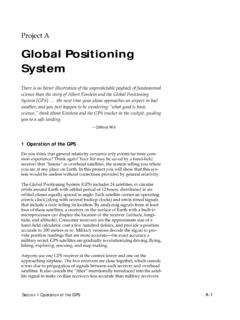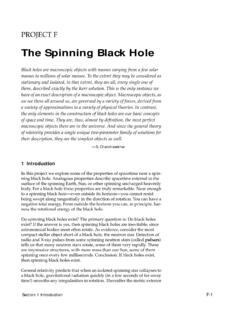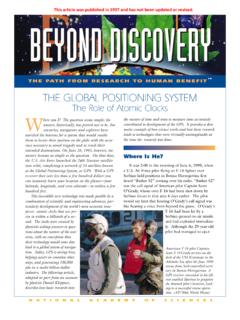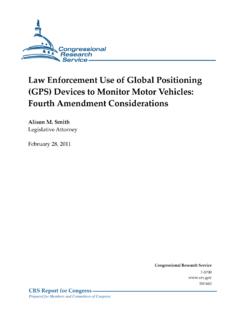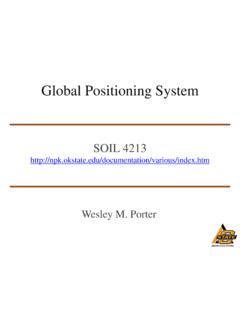Transcription of Chapter 4. Global Positioning System - Edwin F. Taylor
1 May 10, 2017 09:11 GPS160401v1 Sheet number 1 Page number 3-0AW Physics MacrosChapter 4. Global Positioning Operation of the Global Positioning Stationary Approximations Moving The Final Reckoning Applications of the Global Positioning System References4-128 How does the Global Positioning System [GPS] work?9 How accurately can I locate myself on Earth with the GPS?10 Why does the GPS not work when I turn off general relativity ?11 What are practical uses of the GPS?12 Download file name: 10, 2017 09:11 GPS160401v1 Sheet number 2 Page number 4-1AW Physics MacrosC H A P T E R4 Global Positioning System14 Edmund Bertschinger & Edwin F. Taylor *There is no better illustration of the unpredictable payback of15fundamental science than the story of Albert Einstein and the16 Global Positioning System [GPS].
2 The next time your17plane approaches an airport in bad weather, and you just18happen to be wondering what good is basic science, think19about Einstein and the GPS tracker in the cockpit, guiding20you to a safe Clifford OF THE Global Positioning SYSTEM23 Relativistic effects of altitude and speed on clock rates24Do you think that general relativity concerns only events far from commonGeneral relativity:Crucial to theoperation ofthe GPS25experience? Think again. Your hand-held Global Positioning System (GPS)26receiver listens to overhead satellites and tells you where you are anywhere27on Earth! In this Chapter you show that the operation of the GPS system28depends fundamentally on general Global Positioning System includes a network of 24 operating30satellites in circular orbits around Earth with orbital period of 12 hours,31distributed in six orbital planes equally spaced in angle (Figure 1).
3 Each32satellite carries an operating atomic clock (along with several backup clocks)33and emits a timed signal that also codes the satellite s location. By analyzingGPS satellitesystem34signals from at least four of these satellites (Box 1), your hand-held receiver on35 Earth displays your own location (latitude, longitude, and altitude). Consumer36receivers provide a horizontal position accurate to approximately 5 its almost endless applications, the GPS guides your driving, flying,38hiking, exploring, rescuing, mapmaking, and locating your timing accuracy required for the performance of the GPS is so greatGeneral relativity:position andmotion effects40that general relativistic effects are central to its operation: First relativistic41*Draft of Second Edition ofExploring Black Holes: Introduction to General RelativityCopyrightc 2017 Edmund Bertschinger, Edwin F.
4 Taylor , & John Archibald Wheeler. Allrights reserved. This draft may be duplicated for personal and class 10, 2017 09:11 GPS160401v1 Sheet number 3 Page number 4-2AW Physics Macros4-2 Chapter 4 Global Positioning SystemFIGURE 1 Schematic plot of GPS satellites in 12-hour orbits around Earth. Not to : different observed clock rates at different altitudes. Second relativistic42effect, different observed rates of clocks in relative motion. (In this first43analysis of the GPS, we assume all signal propagation occurs in a vacuum.) CLOCKS45 Warping oft-coordinate at different Global Positioning System depends on the reception by a receiver on47 Earth s surface of microwave signals from multiple overhead satellites.
5 BeginSimplest case:clock on tower andno Earth the simplest possible case: Earth does not rotate and the higher clock is49not in a satellite but rather sits on top of a tower at Higherr-coordinate, tower clock communicates with us on Earth, at Lowerr-coordinate, the radially-downwarddr/dtof microwaves that move from the top52to the bottom of the tower. Light and microwaves move at this same rate. For53these conditions,d = 0 and for light,d = 0. Then the Schwarzschild metric,54equation ( ), yields the following radial motion in Global coordinates:55drdt= (1 2Mr)(light moving radially inward)(1)Is equation (1) a surprise? For the first time in our study of relativity,Map speed oflight6= light speed differs from one meter of distance per meter of time.
6 Ah,57but the expressiondr/dtinglobalcoordinates is a unicorn, not measured by58anyone. We need to go back and determine the observable wristwatch time59lapse between two flashes emitted from the clock at the top of the tower. As60usual, the metric converts from Global coordinate separations (on its right61side) to measured wristwatch time lapse (on its left side).62 May 10, 2017 09:11 GPS160401v1 Sheet number 4 Page number 4-3AW Physics MacrosSection Stationary Clocks4-3 Box 1. Practical Operation of the Global Positioning SystemThe goal of the Global Positioning System (GPS) is todetermine your position on Earth in three dimensions:east-west, north-south, and vertical longitude, latitude, andaltitude.
7 Signals from three overhead satellites provide thisinformation. Each satellite emits a signal that encodes itslocal time of emission and the satellite s position in globalcoordinates at that emission event, this position continuallyrevised using data uploaded from control stations on theground. The local clock in your hand-held GPS receiverrecords the local time of reception of each signal, thensubtracts the emissiont(encoded with the incoming signal)to determine the lapse int-coordinate and hence how far thesignal has traveled at the speed of light in Global is the map distance the satellite was from your positionwhen it emitted the signal.
8 In effect, the receiver constructsthree spheres from these distances, one sphere centeredon the emission point of each satellite. Simple triangulationlocates the point where the three spheres intersect. That pointis your location in Global course there is a wrinkle: The local clock in your hand-held receiver is not nearly so accurate as the atomic clockscarried in a satellite. For this reason, the signal from a fourthoverhead satellite is used to correct the local clock in yourreceiver. This fourth signal enables your hand receiver toprocess GPS signals as though it contained an atomic exchanged between atomic clocks at differentaltitudes and moving at different speeds are subject togeneral relativistic effects.
9 Neglect these effects and the GPSis useless (Box 3).The clock at the top of the tower emits two flashes radially downward63(emission events A and B) differentially close together in globalt-coordinate:Tower clock emitstwo downward For this top tower clock,dr= 0 andd = 0, the metric tells us the65corresponding wristwatch time lapsed Hrecorded on the tower clock:66d H=(1 2 MrH)1/2dtAB(d = 0, dr= 0)(2)Figure 2 traces on an [r,t] slice the radially-downward Global worldlines of67the two flashes emitted by the tower clock at events A and B. The Earth clock68receives these flashes at events C and D witht-coordinate (1) tells us that these worldlines have identical slopes (the radialMapt-lapsebetween flashesis constant coordinate speed of light has the same value) at every intermediate71r-coordinate.
10 As a result, the two worldlines are parallel at everyr-coordinate72on the [r,t] slice, so the globalt-coordinate separation between them maintains73its initial valuedtAB. The two flashes arrive at the ground with the initial74difference in (3)The clock on Earth s surface is also at fixedrL. Therefore its wristwatch76time lapse on the ground between the reception of events is similarly given by77(2):78d L=(1 2 MrL)1/2dtCD=(1 2 MrL)1/2dtAB(4)The final step in equation (4) comes from (3). Equations (2) and (4) give us79the relation between wristwatch time lapses of stationary clocks at higher and80lower globalr-coordinates:81 May 10, 2017 09:11 GPS160401v1 Sheet number 5 Page number 4-4AW Physics Macros4-4 Chapter 4 Global Positioning SystemrtowertAttBtCtDrEarthrIdentical slopes of worldlines (identical radial map speed of light) at every 2 Schematic plot in Schwarzschild Global coordinates(t, r)of worldlines oftwo sequential flashes moving downward from the top to the bottom of a tower.
